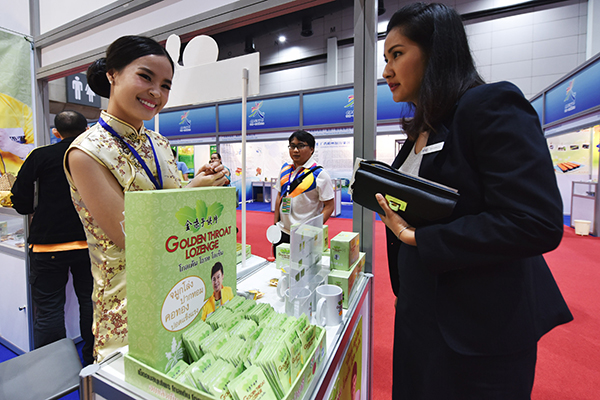 |
|
A staff introduces Chinese products to a visitor at 2015 China-ASEAN Expo Thailand Exhibition in Bangkok, Thailand, on April 2, 2015. [Photo/Xinhua] |
As the world looks to the G20 for a prescription against the weak global economic recovery, the Belt and Road Initiative has become a new driver of international trade and investment.
The World Trade Organization warned in April that the outlook for global trade growth will remain sluggish in 2016, forecasting that global trade would grow by 2.8 percent this year, the same as that registered last year. This will be the fifth consecutive year that world trade volume has grown by less than 3 percent, which would be the longest continuous period of weak global trade growth in the past three decades.
While the picture for investment has been somewhat rosier, as global foreign direct investment flows grew 38 percent in 2015 according to the World Investment Report issued by United Nations Conference on Trade and Development in June, that is still lower than the figure before the onset of the global financial crisis.
Moreover, large-scale FDI flew from emerging markets to developed countries. In 2015, the FDI in developed economies almost doubled to $962 billion, while the FDI in developing economies only increased by just 9 percent.
And the United Nations Conference on Trade and Development predicts that FDI flows will decline by 10-15 percent in 2016, considering the persistent weakness of the global economic recovery.
China remained the largest country in goods trade and the third largest investor in the world, and its outward FDI rose from $123 billion to $128 billion in 2015, according to the UN body.
The launch of the Belt and Road Initiative has been China's response to the sluggish global economic growth and it is a significant move toward a more open global economic system.
As the Silk Road Economic Belt and the 21st Century Maritime Silk Road have started to progress over the past few years, regional trade and investment along the routes have been remarkably boosted.
The annual growth rates for trade and investment along the Belt and Road have been nearly twice as much as the global average, and in 2015 the bilateral trade volume between China and countries along the routes exceeded $1 trillion, Wang Yi, China's foreign minister, said on Aug 3.
China's outbound direct investment in the countries joining the initiative has also soared. According to the Financial Times' cross-border investment database fDI Markets, Chinese investors announced 315 green field investments with a combined value of $75.9 billion in countries along the Belt and Road routes in the 18 months to June 2016.
The recently launched Asian Infrastructure Investment Bank and the $40 billion Silk Road Fund demonstrate that China is also exploring innovations in financing to promote the Belt and Road Initiative. And China and countries along the routes are endeavoring to establish free trade zones and regional integration to further facilitate trade.
In a speech in Uzbekistan on June 22, President Xi Jinping said China has jointly established 46 overseas economic cooperation zones with 17 countries along the Belt and Road.
"As the proposer of the Belt and Road Initiative, China is providing considerable financial support to the construction of the Belt and Road," said Liu Ying, a researcher at the Chongyang Institute of Financial Studies at Renmin University of China."
